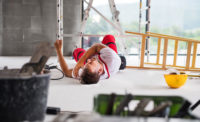In the last issue, we looked at why normal people make decisions that can be compromised or negatively influenced by rushing, frustration, fatigue and complacency, or, more likely, a combination of these states. In many cases, the person is making an exception, such as not going to get the face shield, because it’s really close to quitting time.
In many of these cases, the exception that they are making will be with something that isn’t necessary but rather something that will make the consequences less severe. Regardless of how much of a rush you’re in, you can’t start the car without the keys, but you can drive the car without putting the seatbelt on. You wouldn’t likely get into a canoe or small boat without paddles, but you could forget or decide not to bring lifejackets.
Here’s where it gets interesting: You can leave the dock without paddles if you have a motor on the boat. And you can leave the dock and breakwater area with a small amount of fuel. However, when you run out of gas, now you’re in the water without a paddle.
The problem with critical decisions doesn’t stop with complacency causing normal or habitual at-risk behavior or someone making an at-risk decision because of rushing, frustration or fatigue.
Risk that depends on error
The next concept is a big shift, especially when it actually happens to you. It’s one thing to read something and understand it. It’s quite another to discover it in the moment. The year was 1994. I was skiing in France at Val Isère, which is connected to Tignes by ski lifts and hills. Tignes is 23 km down the road. The resort is huge. My ski companions were all engineers I met skiing in Canada. They were all on a recreational ski club in university. They had maps. They had compasses. They planned every night for where we would ski. We had done this for eight straight days. Then there was a storm.
So, while we wait for the snow to fall (there was lots), let me go back to the original premise this change in perspective came from. People don’t like risk they can’t influence. Many people are afraid to fly. They get scared, upset, fidgety, clamp the armrest with a death grip. You tell them the statistics, but they are of little comfort. It seems everyone would prefer control when it comes to life or limb type things.
In my case, I had blown my knee out (severely damaged ACL) playing college basketball. Although I kept playing until the end of the season and into the playoffs, I really didn’t play much after college because you have to look up at the rim to get a rebound. If you come down on someone’s foot, you can roll your ankle or stress your knee — which, in my case, I knew was hanging by a thread (literally a thread of ligament tissue). I couldn’t afford to hurt my knee and be out of work because at the time (model/actor in Hollywood), my finances were also hanging by a thread. But I didn’t quit because I was worried about my skills. It was because of risk I couldn’t influence. And, as mentioned, I wasn’t alone. Almost everybody is afraid of risk they can’t control.
Skiing, on the other hand, is mostly risk that depends on error. Some falls are very simple: one or two states leading to one or more critical errors, one of which will be a loss of balance, traction or grip. But there are other kinds of errors.
Well, the clouds finally lifted. There was almost a meter of new snow all over the mountains. The engineers had a plan. Things were going well. We were skiing fresh powder all morning long. But in the afternoon, it was harder to find places that were still untouched or did not have lots of ski tracks. However, they had maps. They had compasses. And we were still skiing fresh powder for two hours in the afternoon. For the next run, they told me that we were heading down a steep couloir, which is a narrow band of snow with rocks on each side. Elaine was out in front — she’s an amazing skier. Ian was second; I was third. Skis out far to the side, carving huge powder turns, snow flying in beautiful crescent arcs. Then suddenly, Elaine stopped. Ian stopped, and, begrudgingly, I stopped.
“Why did you stop?” I asked, with frustration clearly discernible in my voice.
“Larry, we have to go back. And if you fall, you will die.”
What had happened is that we had gone down the wrong couloir. This one just ended at a cliff.
We had to side-step back up. It was about 40 degrees Celsius so each step up was effortful. If I fell, I might take Ian and Elaine with me. I started to freeze. So, scared I could barely move. But there wasn’t room for them to get around me. I had to start climbing or side-stepping, up the hill. I forced one leg to move, then the other, then the upper leg again. Slowly, I was moving up the hill; Ian and Elaine following. Every move thought about. One step after another.
When we had climbed up a few hundred meters, I could see the top. We weren’t really safe yet, but I could see safety, and I distinctly remember saying to myself, “It’s a good thing I quit playing basketball because it’s far too dangerous!” And that’s when I realized that risk that depends on error or not making any mistakes. Risk you can’t influence stays pretty much the same. But risk that depends on not making any mistakes are usually based on the assumption that you’ll be paying attention. But as we’ve discussed, over time (skiing for years and years), it is only natural for your mind to wander, or to not think everything through.
I assumed the people I was skiing with knew where we were going. I didn’t double-check, they didn’t double-check. But in a rush to ski one more untracked run, combined with a lot of complacency, we nearly made a fatal error. Good thing we weren’t playing basketball.
Deliberately increasing mind not on task
However, or perhaps unfortunately would be a better word, there’s another aspect of deliberate risk and error that is also worth discussing. When people do things they know will take their mind off task and will increase risk, they will make both of the first two critical errors at the same time.
In other words, they are deliberately increasing the risk of a defenceless moment even though they may not be aware of how much they are increasing the risk or how much risk there is for a serious injury or incident when their eyes and mind are both not on task at the same time. Probably the most common example of this is texting or reading something on your phone when you’re moving or when things are moving around you. But there are many other forms of distraction.
Habits can also play a part, especially if you are so used to walking and texting or driving and texting that you don’t even think about it anymore. However, many people try not to text and drive or not to even talk on the phone when driving. But, as we‘ve discussed, most people also make exceptions if there’s enough rushing, frustration, fatigue and complacency involved.
If they are making an exception to their own rule, then they probably will think about it when they decide to look at their phone when they’re driving or moving. In most cases, there isn’t a problem. We know that as long as we have our mind on task and on the risk at the moment, we can take our eyes off the road for a second without causing a big problem. But as we do this more often, we get a little more comfortable. Pretty soon this isn’t a new activity, it’s a familiar one.
The extra second
Still, everything is OK, until that extra second. Something caught your eye for that extra second, which you weren’t expecting. So, although you, me or another person may have been doing something deliberately that could be distracting, we didn’t think we would actually get distracted for that extra second. And that extra second is always unexpected. It can also cause big problems, especially if you’re driving 100 km/h or 60mph because you’re traveling 27.7 metres a second or 88 feet per second.
Almost everybody has experienced being distracted by that extra second. Some just had close calls, some had minor rear-end collisions or fender benders and others had worse (hit a pedestrian or someone on a bicycle). They knew it was a risk. What they didn’t know was the risk of the extra second.
What’s also interesting is that most of them said they had experienced close calls before from the extra second but because nothing happened, they didn’t really think about it. The second critical error reduction technique is really useful here. You can do risky things, but only for a very short time. Once the fear or skill does not preoccupy you anymore, you can’t really stop the risk of the extra second very reliably. And unless you think about the extra second, you could very easily move into the line of fire or lose your balance, traction or grip, which will increase the risk of injury or incident.
There are two changes in perspectives brought forth in this article, and they are the two ways people can deliberately be increasing the risk of a situation without knowing how much more they could actually be increasing the risk.
Not realizing that the risk depends on error or not making any mistakes, will likely grow over time to exceed the risk for things you are not comfortable with — like risk you can’t influence (basketball vs. skiing).
In situations where people are willing to do things they know could be distracting, they didn’t contemplate the risk of the extra second.
In the next issue, be ready to understand what it takes to improve quality, production efficiency and customer relations.



